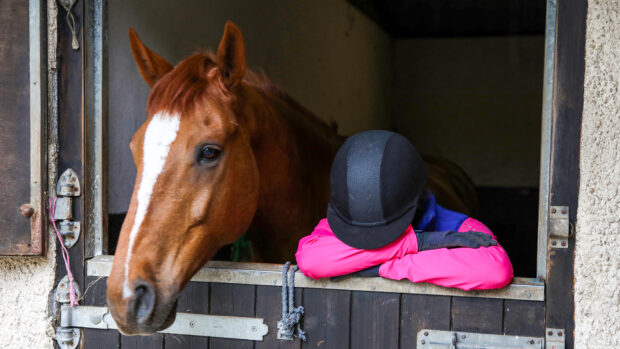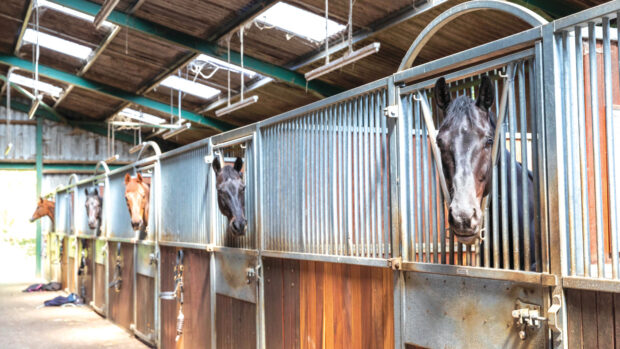If your horse is approaching his or her later years or has suffered a career-ending injury, you’ll find you have to make some hard choices. They can’t be ridden anymore, and the hustle and bustle of a busy livery yard may become too stressful for a horse who might have complex medical needs, or struggles to get along in a herd of younger horses. If, like most owners, you don’t have a field out the back of your house where you can peacefully retire your best friend, one option that is growing in popularity is retirement livery.
Oonagh Meyer, head of approvals at the British Horse Society (BHS) says: “These are generally full livery yards, which cater specifically for elderly or retired horses. It can be an expensive option depending upon how the horses are managed.
“Make sure you research and visit any establishment before placing your horse in their care. It can be daunting trusting your horse with someone, and although there are plenty of retirement livery yards around, it is important to know that the standards of care are as high as you expect. That is why the BHS runs its livery yard approval scheme, providing reassurance to horse owners.”
Retirement livery can be cheaper than full livery, depending on where in the country you live, while it’s typically more expensive than DIY due to the care levels provided. Prices average from £40 to £65 per week. The yard typically provides full care, but not facilities humans want like arenas, tack rooms, and warm lounges.
At most retirement livery yards, the horses are turned out in a herd, which is usually quieter and more stable than herds with horses coming and going. Nicky van Dijk, who runs Happy Horse Retirement Home in Brecon, Wales, explains: “The horses are back to nature; back to the herding instinct. They do everything together. A lot come from competition yards where horses are coming and going, but they can relax here because every horse is doing the same thing.”
Horses at Nicky’s yard are out 24/7 in summer and stabled at night in the winter.
She goes on to explain: “When owners bring horses, they ask, can I get my horse in and groom it? I prefer them not too because it causes the other horses to gallop back and forth.”
That’s probably the biggest different between normal full livery and retirement livery: you completely hand over the care of your horse. You can visit the horse, but you might not be allowed to take it out of the field and do what you like with it. Nicky observes: “Choosing retirement livery is an unselfish decision. They’re doing it for the horse.”
Many of the owners live far away. Nicky says she has horses from Dubai, France, and Spain, as well as all over the UK. Cheryl Bray, the owner of a retirement yard in Gloucester, has an owner from the United States
“She may be able to visit in a few years,” Cheryl explains. “She has a pony that’s been a recurrent laminitis sufferer for 10 years. She was going to have him put to sleep to secure a pain free/worry-free future, but then she learned about our place through a friend.”
Because you might live nowhere near the yard, make sure it is trustworthy, providing excellent care. Cheryl tells H&H: “Best advice I can give is to visit the yard, get references and make sure you can visit unannounced.” She adds: “I’ve actually never had a livery owner turn up unannounced, but it is written into the contracts that they can if they want to.”
With geriatric horses and absentee owners, it goes without saying that the yard owner deals with a lot of medical issues and will ultimately be the one who makes the call as to when is the right time to put the horse to sleep. Owners need to be comfortable with that.
Nicky says: “[The yard owner] needs a lot of medical knowledge, like a human care home. We can tell when it’s time to let them go – we know the horses so well. We discuss it with the owner, but it’s our decision as the owner doesn’t see the horse. They are put down here and cremated.”
It seems like a difficult choice, sending your horse to a yard potentially hundreds of miles away and completely entrusting it’s care to someone else. But if it’s a good, conscientious retirement yard, it could be the best thing that happened to your horse.
Rowena Kennedy lives near Glasgow and her ISH gelding, Ollie, sustained a suspensory injury that meant he wasn’t able to do his previous level of work and he wasn’t suitable as a horse that hacks out now and then. The winter turnout at her yard in Scotland was hard on him.
Rowena says: “He got sore as soon as it froze. I chose the place in Devon as I’d been following it on [Facebook] for a couple years… I knew the ground would suit him, they turn them out in herds that suit the horse, boys and girls are separate, and the weather down there is better.”
It wasn’t an easy choice. Rowena reflects: “At first I found it really hard, I was used to him being at the yard. It took me years to decide to send him, but it was the best decision I made. He’s loving it down there.”
For all the latest news analysis, competition reports, interviews, features and much more, don’t miss Horse & Hound magazine, on sale every Thursday.




